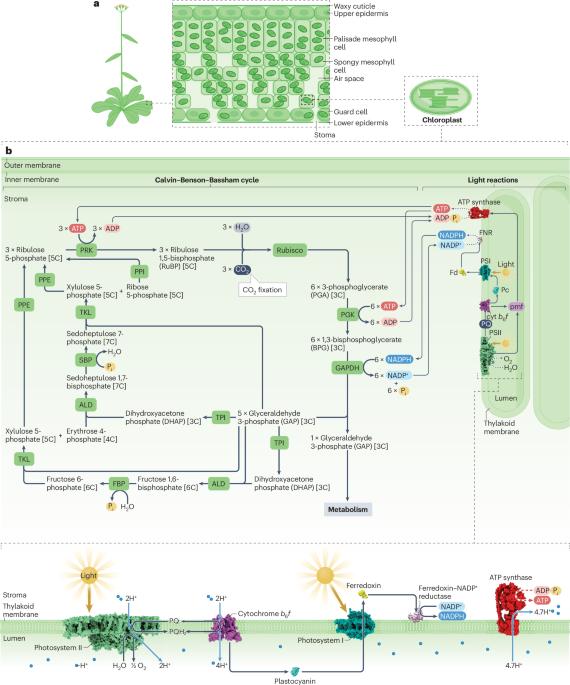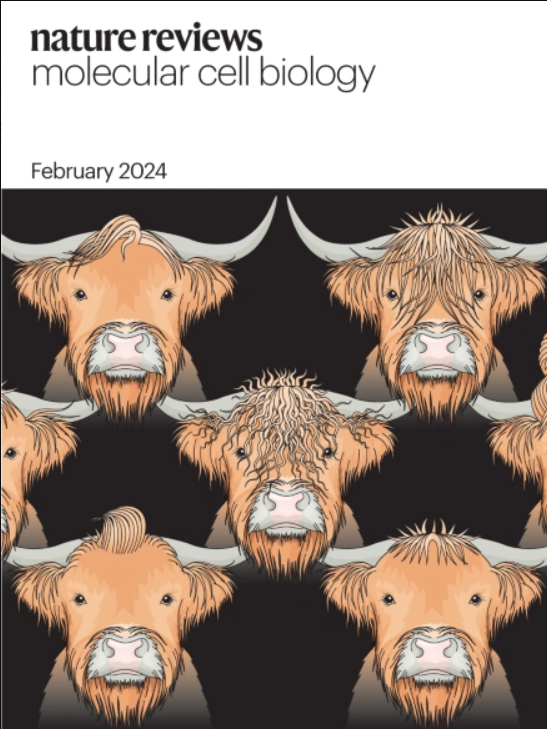光合作用电子传递链的结构、调节和组装
IF 90.2
1区 生物学
Q1 CELL BIOLOGY
引用次数: 0
摘要
叶绿体类囊体膜的电子传递链利用太阳能将水分解成电子和质子,产生能量梯度,驱动以NADPH和ATP形式形成的光合燃料。然后,这些代谢物被用来通过叶绿体基质中的卡尔文-本森-巴萨姆循环将二氧化碳固定到生物质中。分子遗传学、结构生物学和光谱学的最新进展为光合电子从光子捕获到ATP产生的分子转移过程提供了前所未有的理解。具体来说,我们已经深入了解了光合复合体组装成更大的超复合体、类囊体膜组织以及有效的光收集、光保护和氧气演化的机制。本文综述了被子植物类囊体系统的研究进展,概述了光合链各组成部分的结构、功能、调控和组装等方面的研究进展。我解释了太阳能是如何通过光合电子传递链被收集并转化为化学能的,它的成分是如何整合成一个复杂的膜宏观结构的,以及这个组织是如何有助于调节和光保护的。本文章由计算机程序翻译,如有差异,请以英文原文为准。


Structure, regulation and assembly of the photosynthetic electron transport chain
The electron transfer chain of chloroplast thylakoid membranes uses solar energy to split water into electrons and protons, creating energetic gradients that drive the formation of photosynthetic fuel in the form of NADPH and ATP. These metabolites are then used to power the fixation of carbon dioxide into biomass through the Calvin–Benson–Bassham cycle in the chloroplast stroma. Recent advances in molecular genetics, structural biology and spectroscopy have provided an unprecedented understanding of the molecular events involved in photosynthetic electron transfer from photon capture to ATP production. Specifically, we have gained insights into the assembly of the photosynthetic complexes into larger supercomplexes, thylakoid membrane organization and the mechanisms underpinning efficient light harvesting, photoprotection and oxygen evolution. In this Review, I focus on the angiosperm plant thylakoid system, outlining our current knowledge on the structure, function, regulation and assembly of each component of the photosynthetic chain. I explain how solar energy is harvested and converted into chemical energy by the photosynthetic electron transfer chain, how its components are integrated into a complex membrane macrostructure and how this organization contributes to regulation and photoprotection. The electron transfer chain in chloroplast thylakoid membranes uses solar energy to produce NADPH and ATP, which power carbon fixation into biomass. This Review discusses the structure and function of the core photosynthesis complexes and provides recent insights into their regulation and assembly.
求助全文
通过发布文献求助,成功后即可免费获取论文全文。
去求助
来源期刊
CiteScore
173.60
自引率
0.50%
发文量
118
审稿时长
6-12 weeks
期刊介绍:
Nature Reviews Molecular Cell Biology is a prestigious journal that aims to be the primary source of reviews and commentaries for the scientific communities it serves. The journal strives to publish articles that are authoritative, accessible, and enriched with easily understandable figures, tables, and other display items. The goal is to provide an unparalleled service to authors, referees, and readers, and the journal works diligently to maximize the usefulness and impact of each article. Nature Reviews Molecular Cell Biology publishes a variety of article types, including Reviews, Perspectives, Comments, and Research Highlights, all of which are relevant to molecular and cell biologists. The journal's broad scope ensures that the articles it publishes reach the widest possible audience.

 求助内容:
求助内容: 应助结果提醒方式:
应助结果提醒方式:


